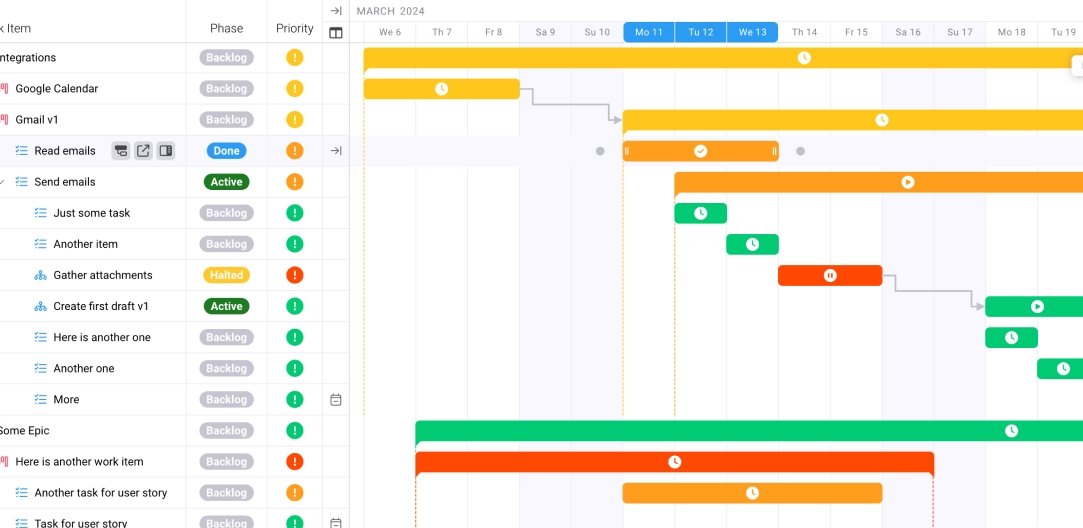
How to Improve Resource Utilization in Your Agency: A Complete Guide to Maximizing Billable Hours
Key takeaways:
Here's a counterintuitive truth: most agencies are leaving money on the table every single day, not because they lack clients, but because people don't log the little stuff. This causes companies to lose 700+ hours a year. If you're struggling to improve resource utilization in your agency while watching profit margins shrink despite having plenty of work, you're experiencing a fundamental operational challenge that plagues the professional services industry. This guide reveals exactly how to transform your agency's resource utilization from a constant headache into a competitive advantage that drives predictable profitability.
The Hidden Crisis in Agency Resource Management
The resource utilization crisis in agencies runs deeper than most leaders realize. While agencies chase new business and focus on creative excellence, they're hemorrhaging profitability through poor resource allocation and inefficient time management. The average profit margin for a digital agency in the U.S. since 2015 is 15%, but this already modest figure masks a harsh reality: many agencies operate at much lower margins due to underutilized resources.
The problem compounds when you consider that Context switching can waste up to 40% of your productive time. Your team members jump between projects, attend unnecessary meetings, and lose focus throughout the day, turning potential billable hours into lost revenue. This inefficiency creates a vicious cycle where teams feel overwhelmed despite low billable utilization rates, leading to burnout without corresponding profitability.
Understanding these challenges is the first step toward transformation. Agencies that master resource utilization don't just survive—they thrive with healthier margins, happier teams, and more predictable growth trajectories.
The Strategic Framework for Resource Optimization
Creating a systematic approach to improve resource utilization requires more than tracking hours—it demands a comprehensive framework that aligns your entire operation. The most successful agencies build their resource optimization strategy on three pillars: visibility, accountability, and continuous improvement.
Start by establishing baseline metrics for your current utilization rates. The gold standard to shoot for is 60% billable utilization, though this varies by role and seniority level. Directors might target 30-40% while junior team members aim for 75-80%. These differentiated targets reflect the reality that senior staff spend more time on business development, team management, and strategic planning.
Your framework should include clear definitions of billable versus non-billable work. Many agencies struggle because team members don't understand what qualifies as billable time. Client meetings, research for specific projects, and documentation all typically count as billable, while internal meetings, professional development, and administrative tasks usually don't. Creating detailed guidelines eliminates ambiguity and ensures consistent tracking across your team.
Implement a governance structure that reviews utilization weekly at the team level and monthly at the agency level. This regular cadence ensures you catch problems early, whether it's a team member struggling with too much non-billable work or a department consistently missing targets due to poor project scoping.
Implementation Tactics That Actually Work
Moving from theory to practice requires specific, actionable tactics that improve resource utilization without overwhelming your team. Here are five proven strategies that deliver immediate results:
1. Time Blocking for Deep Work
Encourage your team to schedule dedicated blocks of uninterrupted time for billable client work. Research shows that Implemented utilization targets and tracking for each service division in the company significantly improves performance. Create "focus time" blocks in calendars where meetings are prohibited, allowing team members to dive deep into billable work without distractions.
2. Batch Processing Administrative Tasks
Instead of spreading non-billable tasks throughout the week, batch them into specific time slots. Process all timesheets on Friday afternoons, handle internal emails during designated windows, and group administrative duties together. This approach minimizes context switching and maximizes billable time availability.
3. Implement Skills-Based Resource Allocation
Match team members to projects based on their expertise and efficiency levels. When people work in their zones of genius, they complete tasks faster and with higher quality, naturally improving billable efficiency. Use comprehensive resource planning strategies for agencies to build a skills matrix that maps capabilities to project requirements.
4. Standardize Common Deliverables
Create templates and standardized processes for recurring client work. Whether it's monthly reports, campaign setups, or strategy documents, standardization reduces time spent on routine tasks while maintaining quality. This efficiency gain translates directly into improved utilization rates without sacrificing output.
5. Optimize Project Scoping Accuracy
Poor scoping is a utilization killer. When projects consistently run over budget, team members spend unbilled hours fixing problems, destroying utilization rates. Invest time upfront in detailed scoping, using historical data to inform estimates. Tools for managing billable projects effectively can help track scope creep and prevent utilization leakage.
Measuring Success: KPIs That Matter
You can't improve resource utilization without measuring the right metrics. While billable utilization rate is the headline number, several supporting KPIs provide crucial context for understanding your agency's true performance.
Start with individual utilization rates, but don't stop there. Track realization rates—the percentage of billable hours that actually get invoiced and paid. You might have high utilization on paper, but if clients reject charges or you write off time, your effective utilization is lower. The ability to compare your delivery hours to billable hours per project, calculate billable efficiency, and make strategic decisions becomes crucial for long-term profitability.
Monitor average billable rates alongside utilization. The majority of digital agencies have an hourly rate ranging from $175 to $199, but your rates should reflect your value and expertise. Higher rates with slightly lower utilization can be more profitable than maxing out utilization at bargain prices.
Establish team-level metrics that account for role differences. Your creative team might have different targets than your account management team. The annual target for net utilization sits around 50% – 60% for most agencies, accounting for holidays, sick time, and professional development.
Create a utilization dashboard that provides real-time visibility into performance. Include heat maps showing which teams or individuals are over or underutilized, trend lines displaying utilization over time, and forecasts based on current project pipelines. This visibility enables proactive resource management rather than reactive firefighting.
Don't forget about leading indicators. Pipeline strength, project backlog, and resource requests all signal future utilization challenges or opportunities. Deal pipelines were down from previous highs, indicating potential utilization challenges ahead for many firms.
Future-Proofing Your Resource Strategy
The agency landscape continues evolving rapidly, with new technologies, client expectations, and work models reshaping how we think about resource utilization. Agencies that want to improve resource utilization must adapt their strategies for tomorrow's challenges while optimizing today's operations.
Artificial intelligence and automation are transforming how agencies allocate resources. Repetitive tasks that once consumed billable hours can now be automated, freeing teams for higher-value work. Smart agencies are redefining their service offerings to focus on strategic, creative work that commands premium rates while automating commodity tasks.
The shift to hybrid and remote work models requires new approaches to resource management. Without physical proximity, maintaining visibility into team capacity and utilization becomes more challenging. Invest in tools and processes that provide transparency regardless of where team members work. Focus on outcomes rather than hours, shifting from time-based billing to value-based pricing where appropriate.
Client expectations around transparency and value continue rising. Modern clients want to understand exactly what they're paying for and how their investment translates into results. Agencies succeeding in this environment use workflow optimization strategies that save 20 hours weekly to deliver more value without increasing costs.
Build flexibility into your resource model to handle demand fluctuations. Maintain a network of trusted freelancers and partner agencies that can scale up during busy periods without creating fixed overhead. This elastic capacity model helps maintain optimal utilization rates for your core team while meeting client needs during peak times.
Consider how specialization impacts utilization strategy. Agencies focusing on specific industries or services often achieve higher utilization rates because they develop repeatable processes and deep expertise. Generalist agencies might struggle with utilization as they constantly adapt to new project types. Evaluate whether narrowing your focus could improve both utilization and profitability.
Prepare for the continued importance of employee experience in resource planning. Pushing for maximum utilization without considering team wellbeing leads to burnout and turnover, ultimately destroying profitability. Remember that it's 70% cheaper to keep an existing customer than it is to find a new one, and the same principle applies to talent. Sustainable utilization rates that allow for professional development and work-life balance create long-term value.
Conclusion
Transforming your agency's resource utilization from a persistent challenge into a competitive advantage requires commitment, systematic approaches, and continuous refinement. The path to improve resource utilization in your agency starts with understanding where you stand today, implementing targeted improvements, and building systems that sustain high performance over time. Agencies that master resource utilization enjoy higher profitability, better client outcomes, and more satisfied teams—creating a virtuous cycle of growth and success. The journey begins with a single step: committing to measure, monitor, and continuously improve how your agency utilizes its most valuable asset—your people's time and expertise. Start implementing these strategies today to maximize billable hours and watch your agency's profitability transform.
Take action now by conducting a utilization audit of your current operations. Identify your biggest gaps between actual and target utilization rates, then implement one key strategy from this guide. Whether it's introducing time blocking, improving project scoping, or investing in better tracking tools, each improvement compounds over time. Explore maximizing agency profitability through improved margins to build a comprehensive approach that addresses all aspects of your agency's financial health. Your future profitability depends on the resource optimization decisions you make today.
Frequently Asked Questions
What is a good utilization rate for agencies?
A healthy utilization rate typically ranges from 60-80% for production staff, with senior roles targeting 30-50% due to their involvement in business development and management activities.
How do you calculate billable utilization rate?
Divide billable hours by total available hours and multiply by 100. For example, 30 billable hours out of 40 available hours equals 75% utilization.
Why is my team busy but utilization is low?
This usually indicates too much time spent on non-billable activities like internal meetings, admin work, or inefficient processes causing unnecessary rework.
Should every employee have the same utilization target?
No, targets should vary by role, with junior staff having higher targets (70-80%) and senior leadership having lower targets (30-40%) to account for strategic responsibilities.
How can automation improve resource utilization?
Automation eliminates repetitive tasks, reduces administrative burden, and frees up team members to focus on billable client work, naturally increasing utilization rates.
What's the difference between utilization and realization rates?
Utilization measures time worked versus available time, while realization measures how much of that worked time actually gets billed and collected from clients.
How often should we review utilization metrics?
Review individual utilization weekly, team utilization bi-weekly, and conduct comprehensive agency utilization analysis monthly to identify trends and make adjustments.
Can high utilization rates hurt employee retention?
Yes, consistently pushing utilization above 85% often leads to burnout and turnover, which ultimately costs more than maintaining sustainable utilization levels.









